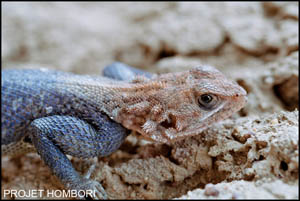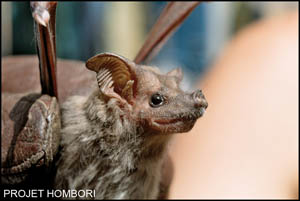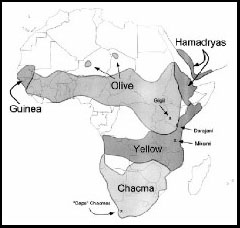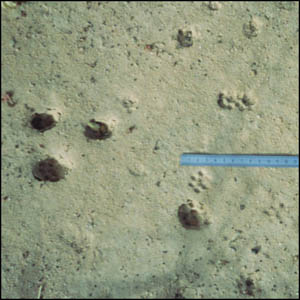Introduction
Mount Hombori is a potential hotspot for vegetal (link
botanic?) as well as animal biodiversity. Thanks to
its peculiar geographical configuration (tabular mountain),
the site has a very special interest for the fauna.
The summit of the mount is indeed highly isolated and
thus represents an ideal refuge for many animal species.
The goal of the zoological part of the Hombori Project
is twofold. We aim first to realize a faunistic inventory
of the Mount and of its neighboring sites. The fauna
of the region is indeed poorly known, in particular
concerning amphibians and insects. The second goal is
to assess the importance of the site in terms of biodiversity
by comparing the faunistic richness and abundance of
the summit and of the surrounding plain.
In order to realize exhaustive inventories, some arthropod
and vertebrate groups have been selected according to
scientific and practical criteria. Priority has been
given to groups presenting a high diversity, convenient
trapping methods or a special scientific interest. Competences
and interests of the scientists of the Hombori team
played a role in the choice of the groups as well.
Taxonomic groups studied and trapping methods
1. Reptiles and amphibians
Mainly night trappings, with nets or by hand
2. Micromammals (rodents and shrews)
Various trapping methods have been used. Pitfall, Longworth,
Sherman and mouse traps were placed for several consecutive
nights on different sites. Individuals were caryotyped
immediately after trapping for identification confirmation.
3. Chiroptera (Bats)
Night trapping with nets
4. Insecta
Insect censuses were done on specific sites, in parallel
with botanical inventories. Those sites were chosen
for their high floristic diversity. Various trappings
were also done during the frequent field excursions.
Trapping methods
- Pitfall traps
A simple plastic cup buried in the ground and filled
with some water and detergent. It allows to catch a
great variety of walking insects, mainly Coleoptera,
Orthoptera, Hemiptera and Hymenoptera.
- Light traps
A gas lamp standing behind a white sheet, allows to
catch various night insects (Moth, Diptera, Neuroptera)
- Nets
Capture of flying insects, mainly butterflies (Lepidoptera-Rhopalocera),
dragonflies and damselflies (Odonata) as well as various
flies (Diptera) and Hymenoptera (wasp, bees, …)
- Bottle trap
A simple PET bottle whose neck has been cut and replaced
upside down will attract many flying insects. It has
to be filled (just a couple of centimeters) with sweet
water or any other liquid attractant for insects.
5. Other
Direct observations during the numerous field excursions
(during the day as well as during the night) allowed
to identify some of the other animal species present
on the summit.
Results
A. Species lists
1. Reptiles and Amphibians
During the expedition, 47 specimens were collected.
Seven of them were brought back alive to Switzerland
and are actually in Natural History Museum of Geneva
(link museum?). Determination is currently in progress.
Here is a provisional list:
- 2 (3) Bufonidae species : Bufo cf. mauritanicus,
Bufo cf. xeros, Bufo sp.
(cf. regularis), Bufo sp.
- 3 Ranidae species : Tomopterna cryptosis,
Hoplobatrachus occipitalis, Pyxicephalus
edulis.
- 2 Hyperoliidae species : Kassina cf. senegalensis
and one other unidentified species from the summit
- 1 Boidae : Gongylophis mulerii (unfortunately,
hit to death with a stick by local people)
- 3 Gekkonidae : Hemidactylus cf mabouia,
Ptyodactylus ragazzii et Tropiocolotes
tripolitanus apoklomax
- 1 (2) Scincidae : Trachylepis quinquetaeniata,
Mabuya sp.
- 1 Agama : Agama cf. agama

Four other species were also collected in 1965 by Papenfuss
: Sphenops delisei, Hemidactylus brooki,
Stenodactylus stenodactylus et Tropiocolotes
tripolitanus
2. Micromammals
- Mus setulosus
3. Chiroptera (Bats)
Two species of Rhinopomatidaehave been caught.
- Rhinopoma hardwithei
- Rhinopoma mircophyllum.

4. Insecta
During this field mission, we collected approximately
300 specimens belonging to more than 130 different species.
Some of the samples are waiting determination in the
Zoological Museum of Lausanne. Here is a provisional
list:
- Coleoptera : 40 sp (5 sp of Carabidae, 2 sp of Cerambycidae,
5 sp of Scarabaeniae, 1 sp of Cetoninae, 1 sp of Aphodiinae,
5 sp of Terebrionidae, 1 sp of Buprestidae, 5 sp of
Meloidae, 2 sp of Histeridae, 1 sp of Coccinelidae,
3 sp of Curculionidae, 1 sp of Anobinae, 1 sp of Lampiridae
et 1 sp of Cantharidae)
- Odonata : 1 sp of zygoptera et 8 sp of anisoptera
(of which Philonomon luminans et Trithemis
sp)
- Lepidoptera : 25 sp (of which Vanessa carduii)
- Hymenoptera : 15 sp
- Diptera : 15 sp
- Orthoptera : 10 sp
- Neuroptera : 3 sp of Myrmeleontidae
- Hemiptera : 9 sp (of which 1 nepidae)
- Mantidae : 3 sp
- Isoptera : 1 sp
- Other arthropods : 1 sp of solifugae (sun spiders)
and 3 sp of scorpions
Antlion
5. Other (direct observations)
Summit
Birds
- Stone partridge (Ptihopachus petrosus)
- Chestnut-tailed rock thrush (Monticola saxatilis)
- Lanner (Falco biarmicus)
- Fox kestrel (Falco alopex)
- Alpine swift (Apus melba)
- Rüppell’s vulture (Gyps rueppellii)
- Egyptian vulture (Neophron percnopterus)
- Mocking chat (Myrmecocichla cinnamomeivent)
Mammals
- Syrian hyrax (Procavia capensis)

The rock hyrax - Procavia capensis
- Olive baboon (Papio hamadryas anubis)

Traces of baboons
The olive baboon has a wide spread distribution from
Middle Eastern to Middle Western Africa. This species
is found in a variety of habitat types from grassland
steppe to tropical rainforests.

Distribution of the olive baboon
The olive baboon is a frugivorous species, but leaves
also constitute a major part of the diet. This species
also eats flowers, roots, grasses, bark, twigs, sap,
tubers, bulbs, mushrooms, lichens, aquatic plants, seeds,
shoots, buds, invertebrates, and small vertebrates,
such as gazelle. Females with infants mostly feed on
the ground for grasses and on low bushes (Estes, 1991).
Olive baboons will sit on the ground and shuffle along
as they feed for grasses and other food found on the
ground (Richard, 1985). Group sizes are variable ranging
from 8 to 100 individuals. This is a diurnal species.
The olive baboon will sleep in trees or on rocky outcroppings.
- Genet (Genetta sp)

Surrounding plain or cliffs
Birds
- Intermediate egret (Egretta intermedia)
- Little egret (Egretta garzetta)
- Black kite (Milvus migrans parasitus) (African
subspecies)
- Pied crow (Corvus albus)
- Little swift (Apus affinis)
- Grey hornbill (Tokus nasutus)
- Hoopoe (Upupa epops)
- Cabanis’ bunting (Emberiza cabanisi)
- Red-billed firefinch (Lagonosticta senegala)
- Senegal coucal (Centropus senegalensis)
- Arabian bustard (Ardeotis arabs)
B. Comparison summit-plain
Data collected during the 2003 and 2005 missions are
being currently analyzed. Nevertheless, we can draw
several conclusions from the provisional data.
First, it seems that the mount represents a refuge for
some mammals that are seldom found in the surrounding
plain (baboons, hyrax, genet, …). Concerning the
entomofauna, levels of diversity are probably similar
between the summit and the plain but many species are
more abundant on the top of the Mountain. Given the
high dispersion potential of many insect species and
the geographical configuration of the site, it is highly
probable that the summit represents a source of diversity
for the highly anthropized surrounding plain. It is
whereas difficult to draw conclusion about the micromammals
inventory because of the very low trapping efficiency
(only one species caught!). We thus aim to develop more
efficient trapping methods during a future mission.
Finally, it is highly probable that the mountain, and
its inaccessible cliffs in particular, shelters many
bird species that are sensible to human disturbance
(for example raptors like the Lanner or the Fox kestrel
and many other passerine species).
Future aims
- To supplement the entomological inventory
- To develop a photo trapping method in order to have
precise data about medium sized mammals present on the
summit (in particular genets and baboons)
- To develop new trapping methods for micromammals
- To monitor animal biodiversity of the summit on the
long- and medium-term
Fauna
Birds, reptiles and small mammifers are abundant on the top of the mountain. Keeping in mind the rich and particular environment of the top insects should also be a particularly interesting group. Mammals On the Mount Hombori a few mammals can be directly observed: among those the olive baboon (Papio hamadryas anubis ) and the rock hyrax (Procavia capensis). At the time of the first mission, we observed quite a lot of hyrax (photo) and we saw some traces of baboon (photo) we also brought an hyrax skull.
In the next mission we hope to collect rodents and insectivores: principally gerbils, mouse and shrews. Our goal is to capture the giant shrew, Crocidura flavescens . Estes, R.D. 1991. The Behavior Guide to African Mammals . University of California Press. Newman, T.K. 2004. Mitochondrial Phylogeny and Systematics of Baboons (Papio) , American Journal of Physical Anthropology 124:17-27 Richard, A.F. 1985. Primates in Nature . W.H. Freeman and Co., NY.
|
